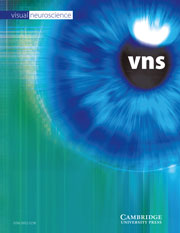Crossref Citations
This article has been cited by the following publications. This list is generated based on data provided by
Crossref.
Borsting, Eric
Ridder, William H.
Dudeck, Kirsten
Kelley, Carol
Matsui, Lisa
and
Motoyama, Janice
1996.
The presence of a magnocellular defect depends on the type of dyslexia.
Vision Research,
Vol. 36,
Issue. 7,
p.
1047.
Hogben, John H.
1996.
A plea for purity.
Australian Journal of Psychology,
Vol. 48,
Issue. 3,
p.
172.
Lovegrove, Bill
1996.
Dyslexia and a transient/magnocellular pathway deficit: The current situation and future directions.
Australian Journal of Psychology,
Vol. 48,
Issue. 3,
p.
167.
Johannes, Sönke
Kussmaul, Clifton L.
Münte, Thomas F.
and
Mangun, George R.
1996.
Developmental dyslexia: Passive visual stimulation provides no evidence for a magnocellular processing defect.
Neuropsychologia,
Vol. 34,
Issue. 11,
p.
1123.
Demb, Jonathan B.
Boynton, Geoffrey M.
and
Heeger, David J.
1997.
Brain activity in visual cortex predicts individual differences in reading performance.
Proceedings of the National Academy of Sciences,
Vol. 94,
Issue. 24,
p.
13363.
Demb, Jonathan B
Boynton, Geoffrey M
Best, Mary
and
Heeger, David J
1998.
Psychophysical evidence for a magnocellular pathway deficit in dyslexia.
Vision Research,
Vol. 38,
Issue. 11,
p.
1555.
Cestnick, Laurie
and
Coltheart, Max
1999.
The relationship between language-processing and visual-processing deficits in developmental dyslexia.
Cognition,
Vol. 71,
Issue. 3,
p.
231.
Skottun, Bernt C.
and
Parke, Lesley A.
1999.
The Possible Relationship Between Visual Deficits and Dyslexia.
Journal of Learning Disabilities,
Vol. 32,
Issue. 1,
p.
2.
Slaghuis, Walter L
and
Ryan, John F
1999.
Spatio-temporal contrast sensitivity, coherent motion, and visible persistence in developmental dyslexia.
Vision Research,
Vol. 39,
Issue. 3,
p.
651.
Skottun, Bernt C
2000.
On the conflicting support for the magnocellular-deficit theory of dyslexia.
Trends in Cognitive Sciences,
Vol. 4,
Issue. 6,
p.
211.
Talcott, Joel B
Hansen, Peter C
Assoku, Elikem L
and
Stein, John F
2000.
Visual motion sensitivity in dyslexia: evidence for temporal and energy integration deficits.
Neuropsychologia,
Vol. 38,
Issue. 7,
p.
935.
O’Brien, Beth A
Mansfield, J.Stephen
and
Legge, Gordon E
2000.
The effect of contrast on reading speed in dyslexia.
Vision Research,
Vol. 40,
Issue. 14,
p.
1921.
Iles, Jo
Walsh, Vincent
and
Richardson, Alex
2000.
Visual search performance in dyslexia.
Dyslexia,
Vol. 6,
Issue. 3,
p.
163.
Wright, Beverly A
Bowen, Richard W
and
Zecker, Steven G
2000.
Nonlinguistic perceptual deficits associated with reading and language disorders.
Current Opinion in Neurobiology,
Vol. 10,
Issue. 4,
p.
482.
Skottun, Bernt Christian
2000.
The magnocellular deficit theory of dyslexia: the evidence from contrast sensitivity.
Vision Research,
Vol. 40,
Issue. 1,
p.
111.
Au, Agnes
and
Lovegrove, Bill
2001.
The Role of Visual and Auditory Temporal Processing in Reading Irregular and Nonsense Words.
Perception,
Vol. 30,
Issue. 9,
p.
1127.
Breitenbach, E.
and
Lenhard, W.
2001.
Aktuelle Forschung auf der Suche nach neurobiologischen Korrelaten der Lese-Rechtschreib-Störung.
Zeitschrift für Kinder- und Jugendpsychiatrie und Psychotherapie,
Vol. 29,
Issue. 3,
p.
167.
Pammer, Kristen
and
Lovegrove, W.
2001.
The influence of color on transient system activity: Implications for dyslexia research.
Perception & Psychophysics,
Vol. 63,
Issue. 3,
p.
490.
Au, Agnes
and
Lovegrove, Bill
2001.
Temporal processing ability in above average and average readers.
Perception & Psychophysics,
Vol. 63,
Issue. 1,
p.
148.
Skottun, Bernt C
2001.
On the use of the Ternus Test to Assess Magnocellular Function.
Perception,
Vol. 30,
Issue. 12,
p.
1449.


